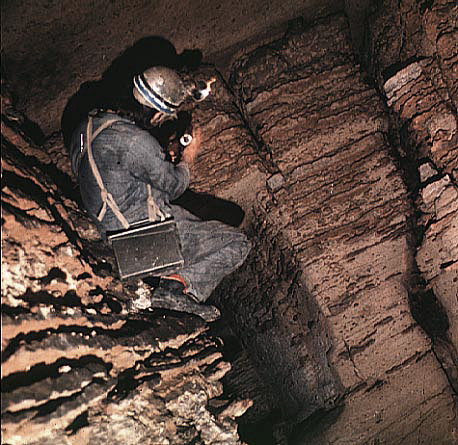Structural, Petrographic and Relative Solubility Relationships in the Sinnett-Thorn Mountain Cave System, West Virginia
By: Stokowski, S.J., Jr.
A PDF version of this paper is available here.
Sinnett-Thorn Mountain Cave System has passages in the limestones of the lower Helderberg Group and is on the eastern limb of a south-southwest plunging anticline. A petrographic examination of the limestone members exposed was undertaken; generally all are sparry allochemical carbonates with a ferroan calcite pore-filling cement that dissolves preferentially over adjacent calcite fossils. The major cave former, the New Creek biosparudite, has the least insoluble material and the coarsest pore-filling ferroan spar.
Different structural features have controlled primary “phreatic” passage locations at different elevations in the cave. The oldest, topmost section of the cave was formed in a maze in the New Creek limestone below a series of vertical crushed and sheared zones in the Corriganville cherty limestone; these zones are approximately 25 cm wide and are interpreted as compressive conjugate shear fractures formed diagonal to regional folding stresses. These passages are not located at the crest of the anticline, but are slightly to the east where the bedding dip is 10º to 15º east. Subsequent passages developed at lower elevations during stable base level periods, and in the limestone-dip-range from 15º to 40º east are following bedding-strike-tending tensional joints in the Corriganville cherty limestone. When the bedding dips are greater than 40º east, passages were not initially formed below fractures in the Corriganville cherty limestone. Some of the fracture permeability controls that were exercised are contained in the lower limestones and are a passage developed along the intersection of two normal faults, and passages following the strike of a drag fold in the upper Keyser limestone. These lower passages are not following the jointing trends of the Corriganville cherty limestone. Two of the reasons that can be postulated for this shift in the stratigraphic location of the primary fracture controls of the solutional porosity are 1) water flowing along open joints in the Corriganville that dip less than 50º west is readily channeled along the shallow-dipping chert beds and is not allowed to react with the underlying New Creek limestone, or 2) that above a 40º east bedding dip, the New Creek and Keyser limestones behave in the aquifer as thick massive carbonates.
In contrast to the active role in groundwater movement played by the solutional passages and fracture permeability mentioned above, there are passively formed “wells” connecting different levels of the cave. These wells follow steeply dipping fracture zones that are interpreted as compressive shear fractures related to local folding stresses. The wells have, at least initially, not channelized groundwater flow. Only one other major passively formed solution void has been found. It is in the “Big Room”, where the New Creek limestone has been stratigraphically repeated by reverse faulting, and was developed subsequent to the major passage.

Image taken in Sinnett Cave, West Virginia in 1974.
From:
Stokowski, S. J., Jr., 1977, Structural, Petrographic and Relative Solubility Relationships in the Sinnett-Thorn Mountain Cave System, Pendleton County, West Virginia (Abs.): The N.S.S. Bull. 41(1), 1979, p. 10 (Presented at the 1977 National Speleological Society Convention, Alpena, Michigan).